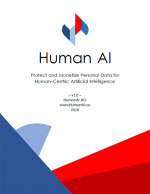Protect and Monetize Personal Data for Human-Centric Artificial Intelligence
Advances in computing power, communication protocols, and mobile technologies make it possible for the first time to collect and analyze massive amounts of data in real-time, which brings the capabilities in machine learning and artificial intelligence (AI) from research to business applications.
Abstract
Data is the most precious asset in the digital society.
It has been widely leveraged to build predictive models thereby optimizing marketing campaigns, product recommendations, and service personalization.
However, existing approaches to collecting personal data are far from acceptable.
More important, users who generate and provide data receive no benefit although their data creates huge values.
We thus utilize human artificial intelligence, edge computing, and blockchain to create an autonomous, secure, and privacy-preserving system that protects personal data and meanwhile bringing benefits of artificial intelligence.
Blockchain and smart contracts are crucial as they guarantee autonomous payment, access control, and data integrity.
Consequently, users will be empowered to unlock and monetize personal data but keeping it private and unseen throughout the whole process.
They can tune trade-off between data privacy and service personalization on their own.
On the other hand, businesses will be able to access additional data sources and only pay for insights and aggregated results.
More important, we provide a solution to help businesses stay in compliance with forthcoming data protection laws and regulations.
What is Human-AI and Blockchain?
According to Prof. Alex “Sandy” Pentland, a Human-AI is something that “is not a machine, but rather a cyberculture that we can live in as Humans, with a human feel to it” (A. “Sandy” Pentland, 2017b).
A Human-AI system combines humans with AI automation to extend the intelligence capabilities of both parts.
In a Human-AI system, humans are able to interact with AI algorithms to understand what assumptions and decisions the algorithms are making on users’ behalf, for example, by changing an algorithmic parameter and inspecting the changes on the output.
Compared to traditional AI systems, a Human-AI system will have improved user trust and automation adoption (Dietvorst, Simmons, & Massey, 2016; Lyons et al., 2016).
Also, combining humans with AI will perform better than humans and AI working alone (A. “Sandy” Pentland, 2017a).
Blockchain, on the other hand, is a distributed digital ledger that ensures transparent and incorruptible transactions in practice.
It enables the coding of smart contracts that will execute automatically when a pre-defined state is reached.
Blockchain and smart contracts make it possible to conduct micropayments and state transfers securely and automatically in a peer-to-peer network.
What’s Related

Favorites





